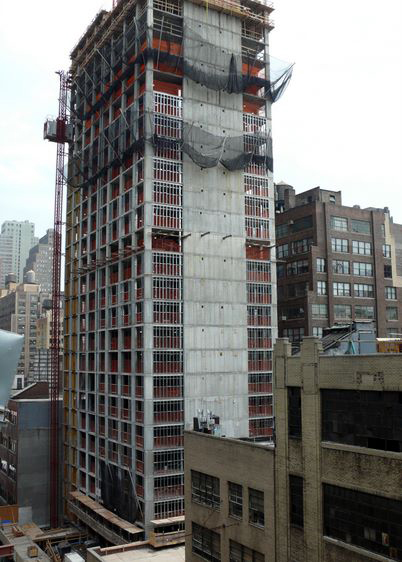Below is a precise method statement for superstructure concrete works which is applicable for any kind of the project.
Setting out: Prior to the commencement of the works, confirm and establish all reference points and levels. Locate, confirm and protect control points prior to starting the site concrete works.
Formwork Requirements
Make sure that the formworks should support the loads imposed on them by the fresh concrete together with additional stresses imposed by vibrating equipment and by construction traffic.
Formwork/Shuttering will be installed as per approved drawings and secured against lateral force by concrete.
Ensure that formwork erected and installed is rigid, water tight and dimensionally stable.
Formworks release agent material as approved by the consultant will be applied prior to the concrete casting to ensure good surfaced finished of concrete.
Before placing concrete, all dirt, debris and other foreign matter shall be removed.
Before concrete placing commences, all wedges and other adjusting devices shall be secured against movement during concrete placing.
Before placing concrete, make sure all the reinforcement is ready, cover blocks provided, all MEP installations completed (if any) and all necessary approvals have been taken.
Cover to Reinforcement: The concrete cover to reinforcement shall be 40 mm unless otherwise specified in the drawings.
Construction Joints:
The construction joints will be provided in those positions where they are shown on the drawings. Whenever concrete is to be bonded to other concrete that has hardened, before deposition of further concrete, the contact surface shall be clean, hard and sound.
Concrete Placement Procedure:
The concrete work shall confirm to all requirements of BS 8110, Structural use of concrete.
No concrete shall be placed in the permanent works until the client/consultant has approved the materials.
Concrete shall not be placed in any part of the permanent structure until the client’s consent has been given in writing.
The concrete shall be deposited as nearly as possible in its final position. It shall be placed so as to avoid segregation of concrete and displacement of the reinforcement, other embeded items or formwork.
Maximum free fall height / free drop height shall be minimized to 1.5m to avoid segregation.
The concrete will be placed into layers not more than 500mm. or agreed by the consultant.

Layers shall not be placed so that they form featheredges nor shall they be placed on a previous layer that has taken its initial set. In order to comply with this requirement, a layer will be started before completion of the preceding layer.
The vibrators shall be operated at regular intervals to produce dense, compact and homogeneous concrete surface.
The size of the vibrating pokers will be decided considering the layout of reinforcements and will ensure consistent mass is obtained without segregation.
During concrete placement operations it will be ensured that ambient temperature is ≤ 42°C while concrete temperature ≤ 30°C.
Independent Testing Laboratory ITL Testing
At arrival of concrete at site, the ITL will do all necessary site checks of concrete i.e. concrete temperature, slump, air content and etc. as per delivery note & specified testing frequency as per specification.
ITL will take the cubes for 7 & 28 days compressive strength and durability as specified.
Protection of Fresh Concrete:
Freshly placed concrete shall be protected from rainfall and water running over the surface until it is sufficiently hard to resist damage.
No traffic shall be allowed on any concrete surface until it is sufficiently hard to resist damage by such traffic.
Freshly placed concrete shall not be subjected to any structural loading until it has attained at least its nominal strength as specified.
Curing:
Concrete shall be thoroughly wetted as soon as the forms are first loosened and shall be kept wet during the removal operation and until the curing media is applied.
The curing process shall commence as soon as the concrete is hard enough to resist damage from the process.
Curing shall be continued for as long as may be necessary to achieve its objectives but in any case for at least seven days or until the concrete is covered by the later construction, whichever is the shorter period.
Removal of Formwork:
Consultant shall be notified in writing before the removal of formwork.
No formwork shall be removed until the concrete has gained sufficient strength as specified.
The period of time elapsing between the placing of concrete and removal of forms shall be approved by the client/consultant after consideration of loads likely to be imposed on the concrete.
Formwork shall be carefully removed, without shock or disturbance to concrete.
As soon as the formwork has been removed, bolt holes in concrete faces, other than construction joints, which are not required for subsequent operations shall be filled.
Discover more from Project Management 123
Subscribe to get the latest posts sent to your email.